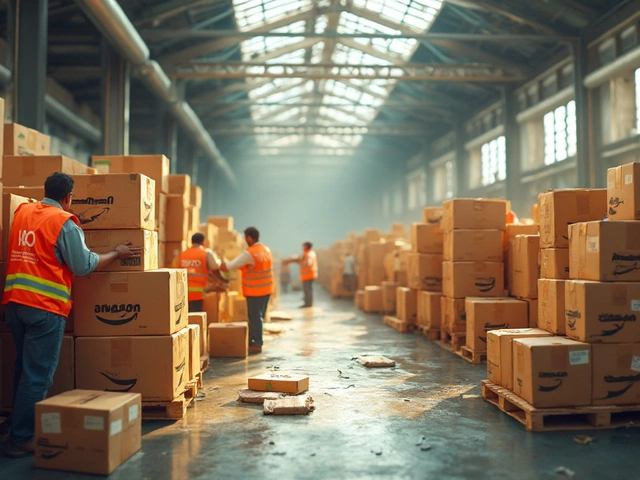Shipping something across the globe might seem like a costly adventure, but it doesn't have to leave your wallet crying. Want to save money while still ensuring your package reaches its destination safe and sound? Let's dive into some savvy strategies for keeping those shipping costs in check.
First things first, understanding the factors that affect shipping prices can help you make smarter decisions. Shipping costs depend mostly on weight and distance, with size and delivery speed adding to the bill. Airlines and ships have limited space after all, and they charge based on what you use.
Picking the right carrier for your needs is step two. Different companies offer various rates and services. Some, like USPS or national postal services, are usually more affordable, especially for smaller, lighter items, while couriers like FedEx or DHL might offer better deals on time-sensitive shipments.
- Understanding Shipping Costs
- Choosing the Right Carrier
- Packaging for Savings
- Frequency and Loyalty Discounts
- Customs and Taxes Pitfalls
- Tracking and Insurance Decisions
Understanding Shipping Costs
Shipping costs can add up fast if you're not paying attention. So, what exactly are you paying for when you ship something internationally? Let's break it down.
First off, consider the weight of your package. Heavier packages cost more—simple as that. Every extra pound means more fuel and space, which means more cash out of your pocket. Even if it's light, the size of the package also matters. Oversized packages can incur extra charges because they take up more room.
Then there's distance. The farther it has to go, the pricier it gets. Shipping from one continent to another with an ocean in between is generally gonna cost you more than sending something next door.
Ever wonder why some packages cost more to deliver even if they're short distances? It's all about the delivery speed. Faster shipping options, like express services, are usually more expensive since they get your package there in less time.
Hidden Fees and Surcharges
Stay alert for hidden fees. Some carriers charge extra for things like fuel surcharges, remote area delivery, or weekend delivery. These can sneak up on you if you're not careful and blow your budget out of the water.
Customs and Duties: The Silent Cost Creeper
When you're shipping across borders, customs and duties can come into play. These are government taxes imposed on imported goods and can sometimes change the game on the final cost. Each country has its own rules, which can make things a bit tricky. That's why it's important to research and understand the customs regulations of the destination country before shipping.
To make things a bit easier, here's a basic table of average shipping costs for small packages from the US to popular destinations:
| Destination | Economy Shipping (5-10 days) | Express Shipping (2-3 days) |
|---|---|---|
| Canada | $15 | $35 |
| United Kingdom | $25 | $55 |
| Australia | $30 | $75 |
This will give you a ballpark idea and help you plan your shipping budget better.
Choosing the Right Carrier
Picking the right shipping carrier is like finding the perfect pair of shoes—it’s all about the fit. The differences between carriers can have a massive impact on your delivery costs and service quality. Looking to save money without sacrificing reliability? Let's talk about how you can evaluate and select the best international shipping partner for your needs.
Understanding Your Options
Big names like UPS, FedEx, and DHL dominate the courier scene. These carriers are known for their speedy delivery services and a robust global network. They’re the go-to for businesses needing reliable and fast shipping. However, don't skip checking out your national postal service. Options like USPS (for the U.S.) or Royal Mail (for the UK) often offer more budget-friendly services, especially for small parcels, though their delivery might take a bit longer.
Comparing Costs
Costs are a top concern, so compare rates rigorously. Most carrier websites provide shipping calculators. Plug in your package details—weight, dimensions, and destination—to get an estimate. This tool helps you see if the price fits your budget. Sometimes, it even pays to mix and match: using a postal service for international segments and a courier within a country for speedier results at a fraction of the price.
Service Highlights
Think about what's important for your shipment. Do you need tracking, insurance, or guaranteed delivery times? Carriers like DHL offer comprehensive tracking for peace of mind, even if it costs more. If timing isn't critical, opting for slower shipping methods with tracking can shave costs while keeping tabs on your package.
Delve into Discounts
Never underestimate the power of discounts. Many carriers offer promotional rates, especially for bulk shippers or loyal customers. Sign up for newsletters or establish business accounts to take advantage of these offers. With some research, you can slash your cost-effective shipping expenses significantly.
To sum up, choosing the right carrier involves balancing costs, speed, and service features to fit your specific shipping needs. Spend a little extra time upfront to make smart choices—it'll save you from headaches later.
Packaging for Savings
Alright, let's talk packaging. How you pack your shipment can make a real difference in cost. Start with the basics: smaller and lighter is cheaper. If your package takes up less space or weighs less, you're in for some savings. It’s like a puzzle—fit everything snugly, with no wasted space.
Tip #1: Use the right-sized box. Oversizing is a common mistake. Shipping companies measure and charge based on dimensions too, so use what fits. You’d be surprised how much cash you can save by just grabbing a smaller box.
Tip #2: Try to use lighter materials. Heavy packaging adds weight, which bumps up costs. Consider bubble mailers for small, non-fragile items. They're lighter and can shave a few bucks off your bill.
Choosing Efficient Packing Materials
- Bubbles vs. Blocks: Using air pillows instead of packing peanuts can save weight.
- Double Duty: Use recyclable materials. They’re often lighter and cheaper. You'll save cash and feel good about going green.
Also, if you’re shipping frequently, don't forget to reuse materials. Recycle old boxes and padding material whenever possible. It’s not only cost-effective but also eco-friendly.
Consider insurance if you're shipping valuables. It's tempting to skimp, but losing a high-value item could cost more in the long run. Some carriers even offer discounted insurance options for frequent shippers, so keep an eye out for those.
By being strategic about your packaging, you're not just saving on your current shipment; you're setting up a system that will keep your international shipping costs down in the long run.

Frequency and Loyalty Discounts
If you frequently find yourself shipping across borders, it’s time to harness the power of loyalty and frequency discounts. Many courier companies like FedEx, DHL, and UPS offer programs that reward you for sticking with them.
These programs work like any loyalty scheme. The more you ship, the better deals you get. It’s kind of like your morning coffee shop punch card, but for international shipping. Maybe you’ll even get some perks like faster delivery or special customer service.
Choose the Right Program
To start, you’ll want to research which courier program fits your needs best. Here’s a quick guide:
- DHL Express Easy: Ideal for small businesses, offering discounts based on volume.
- FedEx Advantage Program: Offers shipping discounts for various business sizes, especially good for e-commerce.
- UPS My Choice: Provides flexible delivery options and discounts for frequent shippers.
Don’t just pick the first option you see; compare the benefits based on your shipping habits and see which one helps slash those international shipping costs efficiently.
Negotiate for Better Rates
Believe it or not, you're not stuck with the rates on the company's website. Give them a ring and see if you can chat about better deals, especially if you're a loyal customer. Sometimes all it takes is asking to unlock better discounts.
Bundle Shipments
An underrated hack to save money is bundling. By grouping your shipments, you might be able to cut down on costs. Fewer separate shipments often mean a lower total price, so plan your shipping schedule to take advantage of this trick.
So, make the most of every trip your packages take. Whether you're a business trying to widen its reach or someone who loves sending a piece of home to friends, these discounts can really ease the strain on your shipping budget.
Customs and Taxes Pitfalls
Shipping internationally can be like stepping into a labyrinth, especially when it comes to customs and taxes. But understanding these hurdles is key to avoiding unexpected costs when using international shipping services.
First off, let's talk about customs declarations. Every package leaving your country needs a customs form detailing what's inside and its value. Underestimating or misrepresenting this can lead to fines, or worse, your package getting stuck at the border. Always provide accurate descriptions and values for the goods you're shipping.
Then there are import duties and taxes, which can vary drastically depending on the destination country. Some places, like the EU, charge value-added tax (VAT) on imports, while others have different duty rates based on the product type. It might take a bit of research, but knowing your destination's tax requirements can save you from a nasty surprise.
Some countries have import tax thresholds— shipments below a certain value aren't taxed. This can guide you in planning your shipping if you're sending multiple items. Dividing shipments to stay under these thresholds can reduce costs but keep the risk of higher postage fees in mind if you go overboard.
Watch out for handling fees. Carriers may charge extra for customs clearance, often called a "brokerage fee." Check if your chosen shipping service includes this in their rates, or if you'll need to cough up more cash once your package lands at its destination.
Quick Tips to Avoid Customs Issues
- Research taxes and duties before you ship.
- Use clear, correct product descriptions.
- Diversify shipments to stay under tax thresholds.
- Factor in the potential of local handling fees.
With these strategies in mind, you'll be better equipped to handle any customs and taxes challenges that come your way. Navigating this part of international shipping might take a little extra work upfront, but it can save you a ton of headaches down the line.
Tracking and Insurance Decisions
When shipping packages internationally, deciding on tracking and insurance can be a bit of a balancing act between peace of mind and cost. Let's break down why these decisions matter and how they affect your overall shipping experience.
Why Tracking Matters
Having tracking on your package means you always know where it is. Most major carriers, like FedEx, UPS, and DHL, offer tracking as a standard part of their service. However, it's essential to check if your affordable shipping option includes it, especially if you're using more budget-friendly postal services. Tracking helps prevent lost packages and gives both sender and receiver some reassurance.
Is Insurance Worth It?
Insurance is crucial for valuable or fragile items. If something goes wrong and your package gets damaged or lost, insurance can help you recoup the cost. Not every package needs insurance, though. It's generally wise to weigh the cost of adding insurance against the value of the item.
Consider insurance if:
- You're shipping high-value goods.
- The item is fragile and could easily break.
- Replacement would be tricky or costly.
Combining Options for Optimal Savings
Finding the right mix of tracking and insurance within your shipping service can provide significant savings without sacrificing security. Compare services—sometimes bundling tracking and insurance through a single provider can be less expensive than adding them separately. Moreover, some loyalty programs or volume discounts can lower these additional costs, especially if you're a frequent shipper.
Equipped with the knowledge of these options, you can make savvy choices that keep your package secure without blowing your budget!





